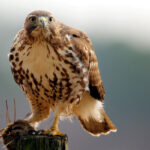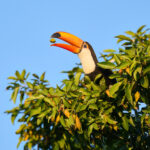By Jerry Lang
First published in Desert Rivers Audubon Magazine
Red-winged Blackbirds, Agelaius phoeniceus, are one of the most common North American birds. During peak breeding years there may be over 250 million pairs across North America from Alaska to Newfoundland to Costa Rica and from the Atlantic to the Pacific coasts.
Agelaius is from the Greek word for gregarious and phoeniceus from Latin for crimson. In the northern parts of their range, the early spring arrival of the males with their red epaulets calling conk-la-ree from perches across the wetlands is a welcome sound for winter-weary humans.
Red-winged Blackbirds (RWBs) are territorial, polygynous (males take more than one mate), gregarious and short-distance migratory. The males’ distinctive red shoulders make them easily recognizable while the much subdued brownish/black females remain less visible. The red coloration on the males results from a mixture of several pigments that are both produced by the birds and consumed in their food, which is somewhat unusual in avian physiology. Males don’t fully develop their red markings until they are 13-15 months old, or after the first breeding season during which most of them are “floaters”, i.e., males without territory.
The red markings on males are apparently only for the purpose of defending territories from other RWB males. Color intensity indicates physical condition in male-to-male competition. Males will threaten and attack other conspecific males as well as many other animals including human intruders.
Older females develop some orangish red coloration and vocalize with mostly a scolding chatter. Females apparently aren’t impressed with the gentlemen in red and will mate with unmarked males. Males may fiercely defend a territory with multiple nesting females, but many females still mate with other males resulting in mixed paternity nestlings.
RWBs go through a series of partial and complete molts with a significant molt from late August into September. This molt is usually complete by October when northern populations begin a southward migration. Some populations in Canada begin their southward migration while they are still molting in late summer. RWB populations in southern areas are, for the most part, nonmigratory. Males and females of northern populations migrate in sexually segregated flocks with female flocks normally migrating farther and leaving breeding areas earlier in the fall and arriving later in the spring than do males.
RWBs are omnivorous with a diet composed roughly of 75% plant material (mostly seeds) and 25% insects and other small animals. The number of insects in their diets increases during breeding season when more protein is needed. Odonates (dragonflies and damselflies) are important insects in RWB warm-season diets. RWBs will also follow plows to feed on unearthed worms and larvae and will feed on a variety of small fruits such as blueberries and blackberries.
RWBs mix with grackles, cowbirds, and starlings in huge late summer and early fall flocks to feed on waste grain and field crops.
Wetlands, either freshwater or saltwater, are the preferred breeding sites for RWBs although they will also use upland areas such as old fields, meadows and prairies. It’s important to have upright residual vegetation from the previous year’s growth. In wetlands, females prefer broad-leafed rather than narrow-leafed cattails. This probably has to do with stronger support higher above water levels thus being safer from predators and more resistant to wind and weather.
In the western portions of North America, Yellow-headed Blackbirds compete with RWBs for wetland nest sites. Yellow-heads usually arrive after redwings have already staked out territory, but they may chase out the RWBs from prime breeding areas where the vegetation is stronger and the water levels are deeper. In these cases, the RWBs are delegated to less desirable peripheral wetland sites more vulnerable to weather and predators. Predators include snakes, raccoons, other birds, etc. Marsh wrens nesting nearby often deprecate RWB nests. An estimated 30-50% of RWB nests suffer predation.
The reproductive season for RWBs is generally the end of April to the end of July. Females construct nests by themselves in three to six days. Nesting materials include grasses, sedges and mosses. The nest is lined with mud and bound to surrounding vegetation. There are usually 3-4 pale blueish-green eggs with brown, purple or black markings per nest. Incubation (solely by the female) is 11-13 days and hatchlings are ready to leave the nest in 11-14 days. Females can lay 2-3 clutches (always in a new nest) per season, and they can reproduce up to 10 years of age.
Males help with feeding of nestlings, and male territorialism decreases once nesting is underway when males focus more on defending nest sites from predators. Once secured, males have a fidelity to their territories year after year. However, an average male bird’s lifespan is only between 2-3 years. Floaters (young males with no territory) are constantly searching for vacant territory, which is usually provided with the disappearance of defending males. Females have a much stronger wetland fidelity and a weak mate fidelity. In other words, once a female finds the right real estate, she doesn’t much care who the temporary owner is!
Migrating RWB populations may play and important role in spreading both St. Louis encephalitis virus and West Nile virus. The impact of these viruses on the birds themselves has not been extensively studied.
Large flocks of RWBs, especially during fall and winter months can cause damage to various agricultural crops. During mid-summer nesting season, RWBs rely heavily on abundant insect populations for calories and protein. With the approach of fall in northern areas, gathering flocks of birds turn their attention to local agricultural crops. In the Dakotas this often means sunflowers. Although corn is abundant, it’s not as attractive to RWBs once the kernels harden. In the southern areas where large numbers of birds overwinter, they can cause damage to sprouting rice and other ripening crops. The fact that public land and non-farmer-owned land near croplands are often RWB roosting areas can be frustrating to farmers since this limits potential control measures.
Control options are limited. In the 1980s and 90s, a surfactant (PA-14) was experimentally used. This material was aerially sprayed on roosting birds most of which subsequently died from hypothermia. Obviously, this was a very non-specific approach and probably killed many non-target species. In fact, some of these operations have been blamed for locally reducing Rusty Blackbird populations – a species that has declined in number more than 85% in the past 40 years.
The current chemical control of choice is Avitrol, 4-aminopyridine, applied to grain bait. Only small amounts are needed since birds consuming the bait exhibit alarm behaviors that frighten the entire flock. According to the manufacture Avitrol does not actually cause pain in the affected birds and, in most cases, the birds recover. Pyrotechnics and other scare tactics are minimally effective at dispersing flocks of RWBs.
Over most of their range, Red-winged Blackbirds are just one of those common birds for most birders. But just as with humans, even the most common of us, have unique and, if we take the time to learn, interesting lives.
Photo by Ed Mattis – Audubon Photography Awards








